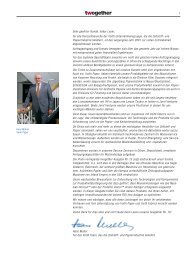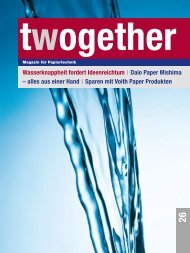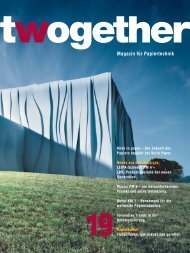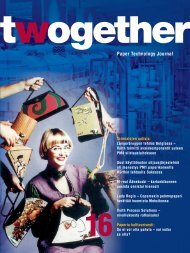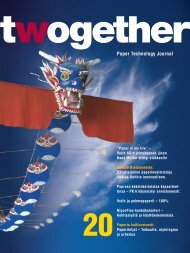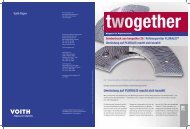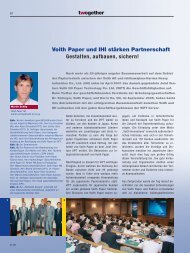You also want an ePaper? Increase the reach of your titles
YUMPU automatically turns print PDFs into web optimized ePapers that Google loves.
Buddhist religious ceremonies. It became<br />
the symbol of purity and a spiritual<br />
meaning was attributed to it. Even today<br />
in Japan, paper ornaments and strips are<br />
regarded as the bearers of glad tidings.<br />
They often flutter on shrines and temples.<br />
The art of paper folding (Origami) was<br />
also born at this time.<br />
During the Edo period (1603-1868) farmers<br />
had to pay tribute to their feudal lords<br />
in the form of rice in the summer and paper<br />
in the winter. The aristocrats used<br />
such paper for private correspondence<br />
but also as toilet paper. <strong>Paper</strong> used by<br />
the farmers for their own purposes was<br />
impregnated with the sap of the Khaki<br />
plant to make waterproof shoes and rain<br />
capes for field work.<br />
Until recently papermaking was<br />
still a secondary occupation for some<br />
Japanese peasant farmers. Of course,<br />
their sheets were not as perfect as those<br />
produced by professional papermakers,<br />
but it was these little flaws in particular<br />
that gave their paper a special charm. It<br />
is uneven and far from smooth, and its fibres<br />
of varying thickness make it a distinct<br />
natural product with an “ecological<br />
touch”.<br />
In the 1980s, the Japanese Naoaki Sakamoto<br />
came up with the idea to revive this<br />
rural tradition of papermaking. In remote<br />
villages he found several farmers who<br />
used to skim off paper by hand. Some<br />
had still kept their original equipment, including<br />
very old screens, in the attic. A<br />
genuine stroke of luck: Sakamoto, in<br />
Tokyo known as “<strong>Paper</strong> Nao”, was able to<br />
convince such farmers to make “ordinary”<br />
Washi paper for him. On the island<br />
of Shikoku, for example, there lived an<br />
old couple whose families had made Senkashi<br />
paper for many generations. The<br />
Korean Buddhist Senka had brought this<br />
craft to Japan, and it is one of the most<br />
original Japanese papers of all. Although<br />
also produced in other regions of Japan,<br />
its thickness, shape and colour had gradually<br />
changed. Only this one remaining<br />
old couple still knew how genuine Senkashi<br />
paper should look and how to make it.<br />
69<br />
Nao finishes the farmers’ Washi with natural<br />
plant dyes applied to the paper with<br />
broad paintbrush strokes. Interior decorators<br />
like to use this Washi grade as a<br />
luxury tapestry or wall decor in the designer<br />
restaurants of Tokyo and Osaka,<br />
where the atmosphere has to accord with<br />
the perfect presentation of the meal. A<br />
large Washi sheet dyed by hand can easily<br />
cost 150 Euro.<br />
However, this high price is not a deterrent<br />
to many Japanese customers, because<br />
in the past 10 years Japan has<br />
become more conscious of its origins.<br />
The reason: while catching up with and<br />
even outperforming Western industrial<br />
economies, Japan tended to neglect its<br />
own roots. The recession that followed<br />
the stock exchange crash in 1991 trig- Tokyo<br />
gered off a resurgence of old traditions<br />
and values. Japanese handicraft has now<br />
become one of these much sought-after Sakamoto,<br />
values, a trend that has helped Japanese<br />
Washi to experience a new, if modest Naoaki<br />
boom.<br />
Martin Fritz Photos:<br />
<strong>17</strong>/04<br />
9



